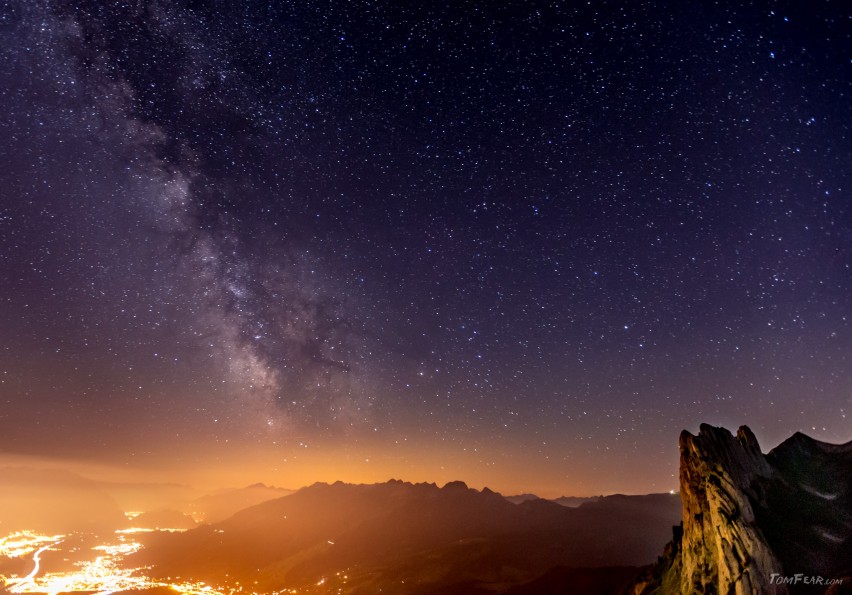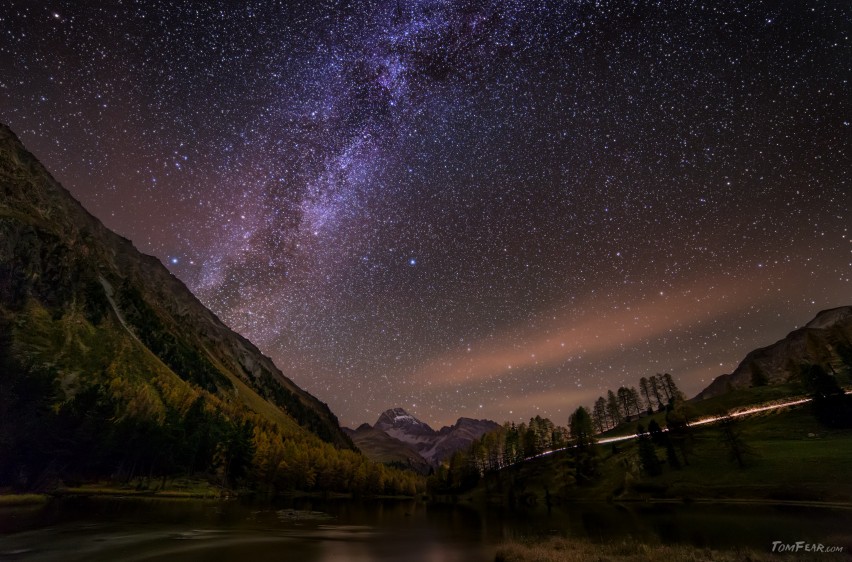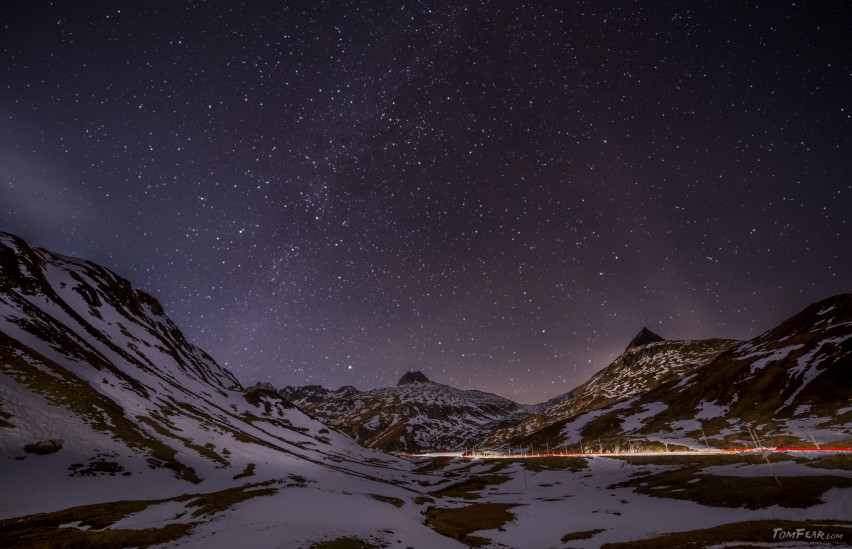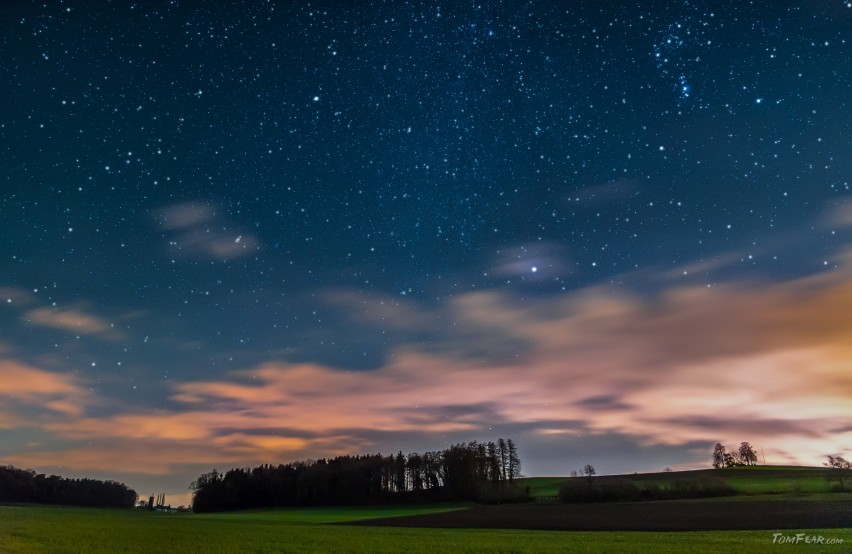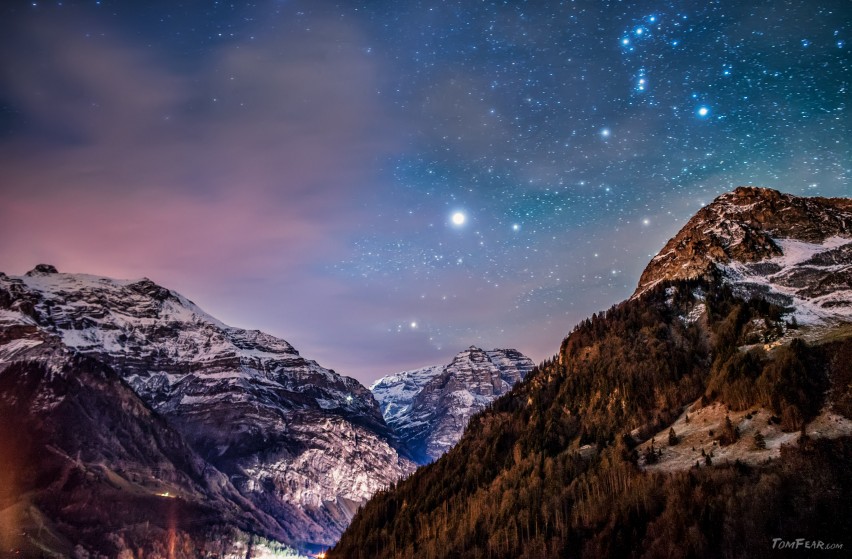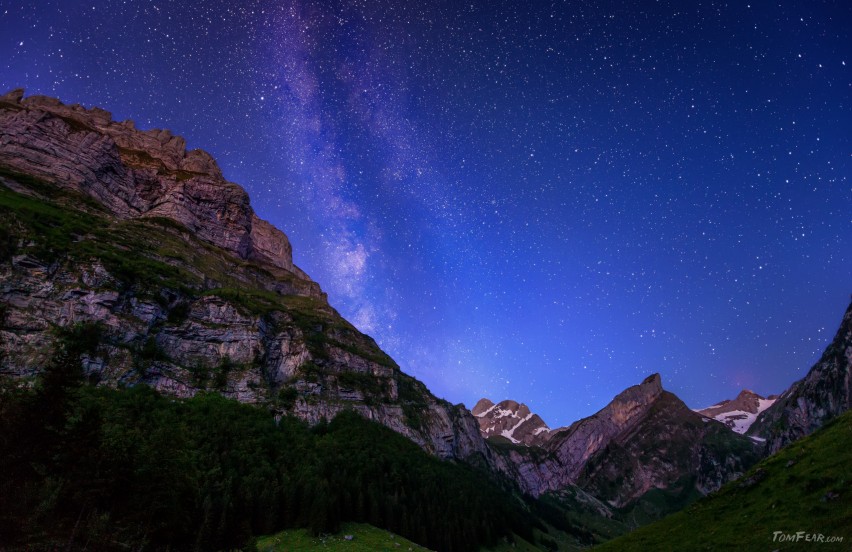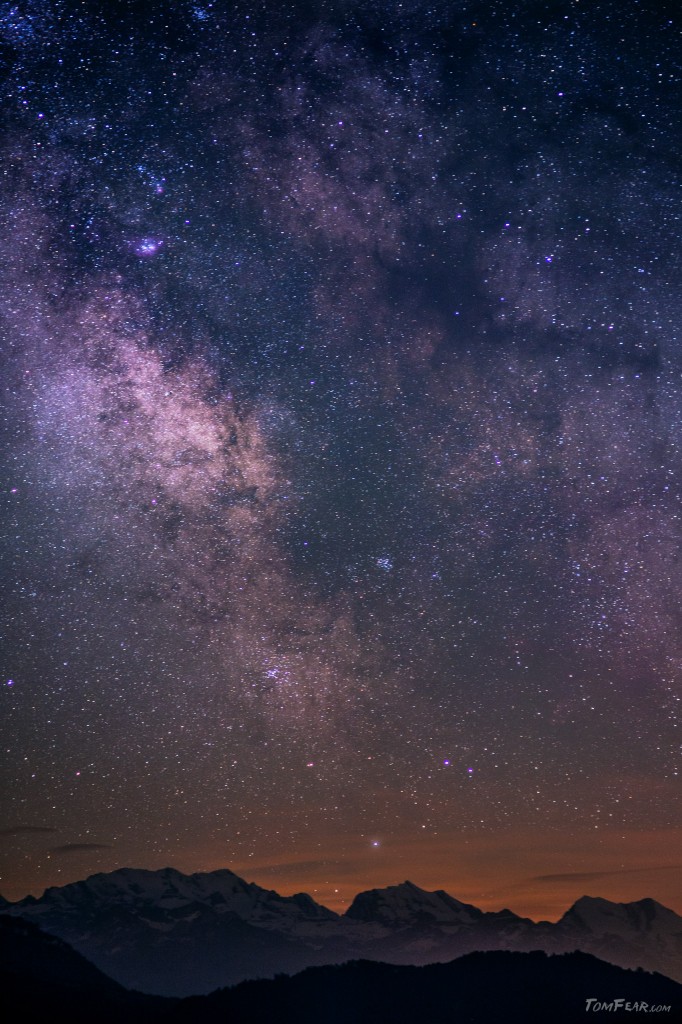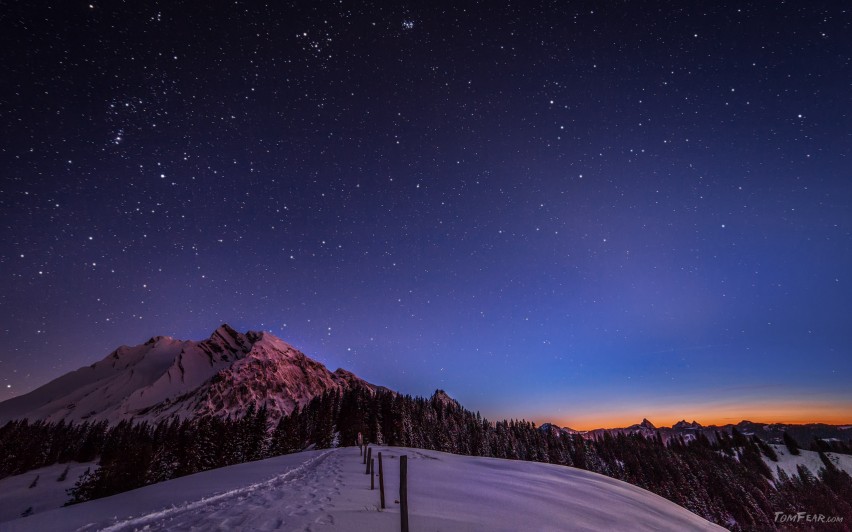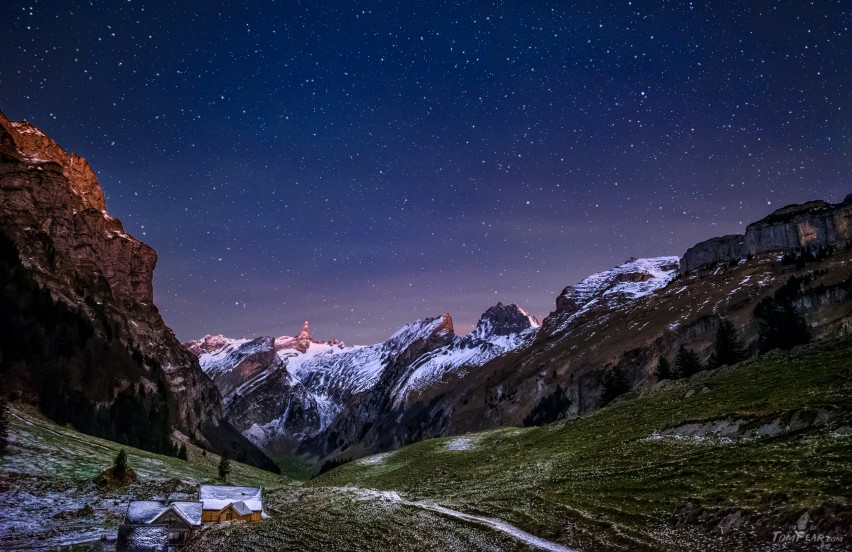s’Rhintl
Posted on Februar 15th, 2015
The bright light pollution in the left corner is the Rhine valley. In german it’s called Rheintal and the inhabitants they call it Rhintl.
I was here on the Alpstein, the near mountains of Appenzell, in the middle of the night and was looking for some starscape images. On this image you can clearly see how intense the light pollution is, even here on the mountains.
On the right corner you can also see the distinctive view of the mountains called Chrüzberg. It was a clear night, not too cold and a few minutes after I took this image the moon was rising up behind me.
Ah, if you ask what this strange smearing above the Rhintl is, this is not a post processing mistake, this is our galaxy the Milky Way ![]()
Bernes Alps
Posted on Februar 9th, 2015
I walked up the steep hill, in the middle of the night, climbed the tall tower and waited the half night to see the sunrise over the Bernes Alps.
It was a bit cold, some degrees below zero and I was waiting until I see the sun rising over the mountains. But didn’t calculate with the high mountain to the east which was covering the sun until the red light was gone. This point is called Blueme (engl. Flower) don’t ask me why ![]() and it was not so difficult to find. Maybe this position is better for a sunset, when the sun shines to the front of the mountains and you can probably see the alpine glow.
and it was not so difficult to find. Maybe this position is better for a sunset, when the sun shines to the front of the mountains and you can probably see the alpine glow.
What I like on this image, are the stars. On the left side, to the east you can already see a bright day sky with a single star and on the other side you find also a few stars in the sky.
Illuminated ways
Posted on Februar 5th, 2015
On the ground the illuminated way through the mountains and above us the illuminated way of the stars, the Milky Way.
I optimized and optimized allways the technique to get starscapes with visible landscapes. But this location under this conditions was a really hard piece of work. I shot this with my Canon 6D and a Samyang 14mm f/2.8. It was a moonless night a valley in the middle of the alps with narrow mountains around me and it was pitch dark.
For this image I took 4 shots. The first one was over 240 seconds with 800 ISO @ f/4 guided with an astronomical tracker. This brought me the beautiful sky. For the foreground without a smearing effect, I turned off the tracker and made a second shot with the same settings. But it was way too dark. Okay I need more light and I pushed up the ISOs to 1600 with 240 seconds, but it is still too dark. Well I thought, go to the limit and I shot a last one with 3200 ISO over 480 seconds! And I became a visible landscape, dark but visible.
It was really difficult to get a usable image under this conditions but I mastered it ![]() It took me about an hour to walk to this spot and more than a half hour to take this single image and another hour to post process it.
It took me about an hour to walk to this spot and more than a half hour to take this single image and another hour to post process it.
Last cars
Posted on Januar 28th, 2015
This is one of the last car here on the Oberalppass, before the winter closed the passage.
Until the late spring, this road will be closed and you need to walk or you can take the train. But I don’t know, whether it will stop on the top or drive through until it reach the Surselva valley. However, actually we wanted to drive up to the Gotthardpass in this night, but unfortunatelly they closed the pass exactly this evening. We checked whether it is still open and it was at the afternoon, but as we reached Realp, the road was closed with a large barrage and big beacons.
So we choosed the Oberalppass instead, thereby we do not go home with empty hands…
Citylights
Posted on Januar 25th, 2015
Guess where the big city is? And this is the reason why you can’t see too many stars near a city.
But I took this photo near my home village a few kilometers outside of Winterthur. And the good thing was, only a few clouds and no moon at the sky. So I could see some nice stars with my new Sony A7s. This was, you can call the first light, of this camera. A small test before I had time to go to the mountains to take real test images.
But I’m also impressed of this image, because you can see so many stars near the citylights.
Orion above
Posted on Januar 23rd, 2015
I was on my way for night photos in the mountains as I could see the clouds in the sky.
I thoughtto me, oh no, clouds again they will cover my beloved stars. But then I realized what the this clouds made to the stars. The clouds worked like a giant soft filter.
If you are watching stars in the sky, then you can recognize the star constellations. But on the image, when you can see all the other stars too, the constellations are no more recognizable, between all the stars. But look at this, when the foggy clouds are moved in front of the stars, can you see the Orion? This is really amazing how some clouds can completely change the sky.
Milky Way in the dawn
Posted on Januar 16th, 2015
The moon was set long ago and the sky begun to lighten up, as the Milky Way was visible.
Bit by bit I could see the galaxy, which is appearing behind the near mountain. This was the last shot of the night, when the darkness was displaced by the light of the rising sun. Nearly two hours before the sun is visible at the horizon, the sky is getting brighter and the stars disappears. So all the work has be done and the photographer could go home to his well-earned sleep.
The center
Posted on Januar 9th, 2015
This is not a shopping center, this is the center of our galaxy.
It looks like they are having a great party there, the biggest light show in the neighbourhood. And the mankind is still waiting to be a part of the interstellar party people. Hey engineers work harder, I want to see it from near ![]()
Until we have useable engines, we have to use our cameras to take photos of the stunning space fireworks.
The stars and the sunset
Posted on Januar 7th, 2015
The sunset is still glowing, while the stars are already visible.
Here in the lonely wilderness, where the foxes and the rabbits say good night, where you can nothing hear than the blowing wind and the air is so clear, you can see the stars up in the sky before the last sun glow disappeared. There is it so darn cold you can freeze your balls of…
But there are a fandfull brave men, defy the hard condtions to get the pictures and bring it to you on your screen in the warm hut in front of a soft crackling fire.
“Tom Fear knows no Fear…” hmm, I already heard this quotation, who can tell me where?
No moon, no snow
Posted on Dezember 30th, 2014
It was a short trip to the Seealpsee in Appenzell. It was for a test shooting with my Sony A7s.
The reason for this place was the darkness. Between the narrow and steep mountains it was no light left from the cities. It was unbelievable dark, I could only see the horizon and the red light on the Säntis. Under this conditions it was not possible to get a useable photo with my Canon 6D, even when I was shooting up to 8 minutes, was the image too dark.
But look at this, one single shot, no stacking, no long exposure only a 10 seconds exposure. Okay it is a bit noise in it, because of the used 12800 ISO, but it is still a pretty nightshot under the hardest conditions I know. I’m really excited about this camera, it will make the night shooting so much easier for me.







